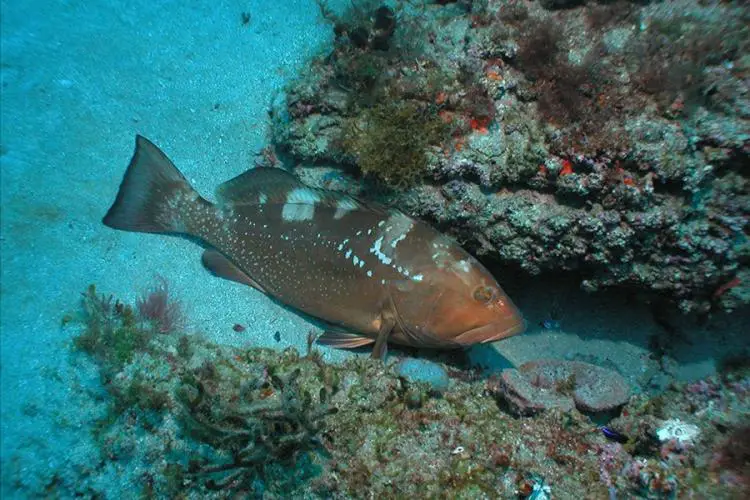What Are Red Grouper?
The red grouper is a type of grouper fish. It is scientifically known as Epinephelus Morio. Like all groupers, this fish belongs to the family Serranidae and the subfamily Epinephelinae, which includes ray-finned fishes. They are opportunistic feeders and mostly stay at the bottom.
An interesting fact about these fish is that they are protogynous hermaphrodites, which means they can change their sex. All groupers are born as females and become males after gaining sexual maturity, usually at age 7 to 14.
Fishing for red groupers is also quite famous, as the fish tastes good. If you want to learn more about this fish, how to identify it, and how to catch it, keep reading this article.
How To Identify a Red Grouper?
As the name suggests, the red grouper shows a dark reddish-brown coloration on the upper part of its head and body. The color fades to a shade of pink on the underparts. Lighter spots and blotches are visible all over their bodies, while darker margins line their fins.
Their bodies are robust, and the scales are small. Their mouth is especially large, large enough to swallow their prey whole. The lower jaw projects a little beyond the upper jaw. Slender, sharp teeth will be visible along those jawlines.
The fish’s dorsal fin contains 11 spines and 16-17 soft rays, while the anal fin contains three spines and eight soft rays. You will also notice three flat spines on their gill cover, with the one in the middle being the longest. On average, their size is around 20 inches or 50 centimeters, though red groupers of a maximum size of 49 inches or 125 centimeters have also been caught. Their weight can be up to 50 pounds.
Where Do Red Groupers Live?
Red grouper are usually found along the coasts of the western Atlantic Ocean.
These fish are distributed over a wide area. In the north, red groupers inhabit the waters of North Carolina of the United States, and the population then stretches further along the coast all the way to Brazil in the south. In Brazil, the distribution extends to Rio de Janeiro, but they are not usually found in northwestern Brazil’s estuaries or river mouths.
A significant part of the population is also found throughout the Gulf of Mexico, especially in the western part of Florida, Bermuda, and Cuba in the Caribbean Sea. Some stray groupers built up a population in the north of Massachusetts.
Is Catching Red Groupers Allowed?
There was a time when catching red groupers was quite a favorite and popular activity among fish hobbyists and a beneficial catch for fishers. It still is, but the scope of fishing for red groupers has been limited to a great extent.
The population of red groupers is divided into two parts depending on their habitat—the first part covers the stock in the Gulf of Mexico and the second part covers the stock of the South Atlantic. There isn’t a lot of red grouper fishing going on in the South Atlantic, so the population there is doing fine. However, the same can’t be said about the Gulf of Mexico.
Fishing is quite common in recreational and commercial fisheries in the Gulf of Mexico, especially for immature fish. Due to the abundance of red groupers at some point in that place, it was always a popular fish to catch, and now the red grouper population is at serious stake in the Gulf of Mexico. Moreover, in some western parts of Florida, lionfish have entered the habitats of red groupers, reducing their numbers further.
To make sure these fish don’t go completely extinct, the U.S. has imposed restrictions to regulate the catching of red groupers. Now, there are commercial and recreational size limits in harvesting red groupers, as well as an annual catch limit. If you catch a red grouper below the size limit, you must let it go.
Can You Eat Red Groupers?
Yes, you can eat red groupers. In fact, they are one of the best-tasting grouper fish out there.
The meat of red groupers is hearty but light. There is a lot of oil in their meat and dense flakes, which increases the culinary versatility when cooking this fish. This fish is an excellent source of vitamins and minerals like sodium. One fillet serving can supply up to 25 percent of your vitamin D needs, 15 percent iron, 20 percent magnesium, and small amounts of B-complex vitamins.
However, like all grouper fish, the red grouper’s bodies have high mercury levels. So, consuming too much of this fish can pose serious health threats. It is best to eat them very rarely, only for special occasions, and in small amounts.
How To Fish For Red Groupers?
Fishing for red groupers is okay if you abide by the regulations. However, there are some things you should keep in mind when fishing as a precautionary measure so as not to harm other fish.
Commercial fishers typically use hook-and-line gear while catching red groupers, which is proven most effective. The gear should include longlines and handlines. In many areas, trawl gear, fish traps, and bottom longlines are prohibited from reducing bycatch.
You might catch sea turtles, snappers, or other groupers when fishing for red groupers. If it isn’t your intention to catch any of these, it is your duty to make sure these animals are not injured while you set them free.
In some areas, you will have to use circular hooks to improve the chance of survival of any fish you catch incidentally. Turtle fishing is not allowed, and circle hooks also reduce the chance of hooking turtles. Moreover, if you are fishing from a charter boat or headboard, you should use appropriate release gear and follow handling protocols for the same reason.
Conclusion
In conclusion, red groupers are ray-finned fishes that are fun to fish for and tasty to eat, but they are also endangered. Our responsibility is to preserve these fish and ensure they don’t become extinct.












Pingback: What Are Grouper Fingers? | Reel Fishing Guru
Pingback: What Is the Difference Between Grouper and Murray Cod? | Reel Fishing Guru
Pingback: Red Grouper vs Black Grouper Comparison: Which is the Better Fish? | Reel Fishing Guru